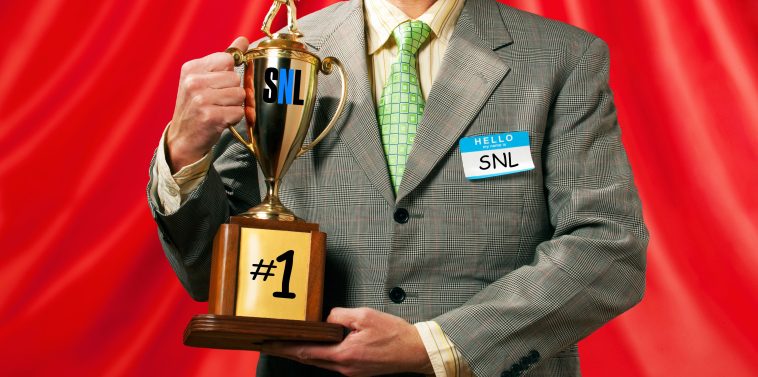Jess Elgene’s final Saturday Night Live audition wasn’t for another six hours, and she was trying not to freak out. The thirty-year-old comedian from Midland, Texas, twiddled her thumbs, did some breathing exercises—in-two-three-four, out-two-three-four—and twiddled her thumbs some more. Sitting in cast member Mikey Day’s dressing room, her holding room for the day, Elgene gazed at the photos lining the walls—a gallery of comedic legends who had walked Studio 8H’s hallowed halls before her. A wave of nerves settled in her stomach as she finally made her way toward the stage to shoot her shot in front of SNL’s legendary creator, Lorne Michaels, and “Weekend Update” cohost Colin Jost.
With a deep breath, she stepped into the light and delivered her set—a mix of stand-up and character work—focusing her gaze on Jost, a friendlier face than the famously inscrutable Michaels. Legend has it no one in the room ever laughs during auditions, but Elgene swears she got a few chuckles. Afterward, she went out for dinner with everyone else who auditioned that day, then spent the next few days waiting for a verdict. Spoiler alert: Elgene didn’t get the part. And she still doesn’t know why. “They don’t give you any feedback,” she tells me. Was it because she didn’t do a character with a Polish accent? Perhaps. Or maybe it’s because she has blond hair and Michaels was looking for a brunette. The thing about variety shows like SNL is that getting the part is often more about the needs of the cast than the talent of the individual. Elgene knows that. Still, she was devastated.
Elgene’s team tried to console her with reminders of SNL’s low pay and brutal schedule, not to mention the fact that the show hardly mints movie stars like it used to, but it didn’t comfort her much. Nor does the fact that the comedy landscape has expanded to the point where traditional gatekeepers like SNL aren’t necessarily as important anymore. (Shane Gillis’s journey from ousted staffer to hosting the show in less than four years perfectly illustrates how a comedian is just as likely to break big through digital fame as through traditional routes like SNL.)
For Elgene and so many other young comedians I spoke to, the allure of SNL remains undeniable. With the show celebrating its fiftieth-anniversary episode this Sunday, it’s a good time to stop and ask: Why in the hell do young comedians still care about being on SNL when there are so many different, arguably less painful ways to make it in comedy today?
NBC//Getty ImagesMany young comedians see social media as a means to an end, especially as Lorne Michaels increasingly fills SNL’s cast with social-media stars like Jane Wickline (right) and Marcello Hernández (left).
Elgene’s agent had a point. First-year cast members on SNL make around $7,000 per episode. Compared with the $20,000 to $50,000 per episode that first-time series regulars routinely earn on other network-television shows, you can see why SNL has long been considered such a grind. Previous cast members have described it as a place where “you are always at risk.” Meaning: You’re only ever a few lousy sketches and unremarkable performances away from getting canned.
For decades, though, the prevailing industry logic was that SNL’s low pay and grueling schedule were worth it for rising performers because of the potential payoff. Play your cards right and you might just become the next Chevy Chase. The handsome, tall comedian was the first to leverage his breakout SNL performances in order to start a major film career, beginning in 1978 with the successful rom-com Foul Play. When Chase left for Hollywood early in the show’s second season, Michaels was reportedly furious—but his departure benefited the show by helping establish its reputation for forming movie stars.
John Belushi came next with National Lampoon’s Animal House in 1978. The film made him an enormous star, just as The Blues Brothers did for Dan Aykroyd and Caddyshack did for Bill Murray. Then came the box-office triumphs of Eddie Murphy, Mike Myers, Chris Farley, Adam Sandler, and Will Ferrell. For almost four decades, at least one former SNL cast member starred in a commercially successful studio comedy every single year. Then, in 2010, the SNL-to-movie-star pipeline started to crack as studios cooled on big-budget comedies and audiences got their laughs from superhero films like Iron Man.
Lorne gives you a rope, and you can either climb it or hang yourself with it.Despite shifts in the film industry, SNL’s breakout stars continued to thrive in Hollywood, largely thanks to Michaels’s strategic maneuvers. If studios weren’t interested in his roster of talent, Michaels simply created opportunities for them himself. “Lorne gives you a rope, and you can either climb it or hang yourself with it,” says Michael Delaney, who often appeared as an extra in SNL sketches before becoming a longtime instructor at the legendary Upright Citizens Brigade (UCB). While at UCB, he performed alongside Amy Poehler and taught talents like Kate McKinnon and Bobby Moynihan.
For those who climbed Michaels’s rope—Jimmy Fallon, Fred Armisen, Tina Fey, Seth Meyers—the reward was substantial. Through his production company Broadway Video, Michaels ensured his favorite performers landed on their feet, whether in a network sitcom like 30 Rock, an indie hit like Portlandia, or a talk show like Late Night with Seth Meyers. Delaney sums it up: “Michaels wants to be the big poppa, the hand that feeds, and Daddy decides who gets what.”
Things are different today. Even with all his power, Lorne Michaels hasn’t been able to escape the realities of a contracting industry. Consider the recent track records of productions from SNL alumni: Shrill, starring Aidy Bryant, was canceled after three seasons. The Other Two, created by former SNL cohead writers Chris Kelly and Sarah Schneider, ended abruptly amid allegations of workplace abuses. Kenan Thompson’s Kenan lasted two seasons before its 2022 cancellation. Apple TV+ dropped Cecily Strong’s Schmigadoon after two seasons in 2024. HBO’s That Damn Michael Che awaits renewal for a third season, while Will Forte and Peacock’s MacGruber languishes after one season. And then there’s Bupkis, Pete Davidson’s semi-autobiographical show that lasted a mere eight episodes before Davidson himself pulled the plug on it.
Many of these shows were likely done in by the double whammy of a pandemic and a writers strike—or fell victim to resource-strapped streamers that are increasingly obsessed with preexisting IP. Still, the contrast between these short runs and the blockbuster films and network hits of decades past is so stark you can’t help but wonder what worthwhile opportunities Michaels can actually serve up for the new crop of comedians sacrificing their sleep and sanity for a shot on his show.
NBC//Getty ImagesIn 2022, SNL cast member Brian Austin Johnson told Marc Maron he doesn’t plan on ever leaving the show. “When I look out at the media landscape, what am I going to be doing in two years?” he asked. “Where am I going to go next?”
For Elgene, the ultimate endgame is SNL itself. Her screen test—the technical term for the final audition done live in hair and makeup at Studio 8H—wasn’t just an audition. It was the culmination of a lifelong dream shaped by SNL’s legendary status. As a kid in Texas, she would reenact Will Ferrell’s sketches on the trampoline with her friends, all dreaming about one day performing at 30 Rock. “SNL is shrouded in so much excitement and energy that even the audition itself is iconic,” Elgene says. Just the chance to stand before Michaels and the show’s producers made her feel part of something bigger—a shared legacy of talent and tenacity and an experience that launched the careers of her comedy heroes. That legacy has everything to do with SNL’s enduring importance to young comedians, even if the show no longer mints Hollywood stars the way it used to.
“I think I speak for a big portion of the comedy world when I say, If you’re offered SNL, you’re probably going to take it.” says Jesse VandenBergh, a seasoned improviser and sketch comedian who spent the 2010s performing on various UCB improv teams and writing for The Chris Gethard Show. The thirty-six-year-old has applied to write for SNL a few times but never auditioned to join the cast. “I know people who have written for SNL, and it is grueling,” he continues. “But at the same time, it’s so important to so many people and so many generations. It’s like the one bit of media that a grandparent and a grandchild might both watch.”
VandenBergh is right about SNL’s ongoing mass appeal. Incredibly, despite a steep decline in overall cable-television consumption, SNL remains hugely popular. Sure, its ratings have slipped, but SNL is still the number-one entertainment series in the eighteen-to-forty-nine demographic. Plus, its overall relevance has arguably reached new heights amid an election year and a landmark anniversary season. And while SNL ascends to near-monocultural status, other opportunities in Hollywood can pale in comparison.
In fact, if given the choice between writing for the hit FX series The Bear and being a cast member on SNL, Elgene tells me she would take the latter, even though the former probably pays better. “The [SNL] credit is just so glamorous and glitzy,” she explains. “It carries more weight than being the head writer of a streamer that lasts a season or two.” She’d choose it over a Netflix special, too. “You may get your moment from a Netflix special, but it only happens once,” she explains. Whereas on SNL, there’s a “moment of that magnitude every single week.”
Jetta Juriansz lives for sketch comedy. The thirty-year-old comedian from Los Angeles has auditioned for SNL six times and previously starred in the sketch-comedy series Studio C alongside Will Forte, but she knows there are other ways to make it in comedy. There are network and streaming comedies. There are new comedy-only digital platforms like Dropout. Improv theaters are staging a comeback. God knows there are podcasts. For a sketch purist like Juriansz, none of them quite compare to SNL.
“I’ve worked on shows where I get to play a funny character for an episode,” she explains. “But that’s not the same as doing twelve sketches in a row where I get to change wigs and be a crazy different person every time.” Not many places outside of SNL and, say, former SNL writer Tim Robinson’s Netflix series I Think You Should Leave offer comedians the kind of experience Juriansz is chasing—especially not in exchange for money.
One potentially lucrative alternative is TikTok. Like Instagram and YouTube, the platform pays creators a sliding fee based on the amount of views their content receives. But Juriansz is quick to point out that the platform isn’t for everyone. For starters, it requires a ridiculous investment of time and energy. “More than ever as a comedian, you are responsible for creating as many opportunities as possible for yourself,” Juriansz says. “And that can be a really good thing for people who like to do that, and it can feel like a huge burden to people who don’t really want to put characters on the Internet.”
NBC//Getty Images
Juriansz says her true feelings land somewhere in the middle. She is occasionally embarrassed by throwing her bits out there, but at the end of the day, she’s happy to have another place to practice her craft. “Doing a character on TikTok is still sketch comedy,” Juriansz says. “It’s just a sketch without a straight man.”
What Juriansz can’t wrap her head around, though, is the all-important algorithm and how, as a comedian, she now has to think about such things, especially when she’d rather focus on her comedy. “Never, not for one second, when I moved to L.A. to start doing comedy at nineteen, did I think, Oh, as a comedian, I’m going to also be considering the algorithm,” Juriansz says, laughing at the lunacy of it all. “It’s really weird to think about on top of all the other things I’m thinking about, like, Comedy comes in threes, make sure to escalate the bit, and use the right hashtags when you post.”
Juriansz tries to keep it all in perspective. She sees social media as an imperfect but increasingly important tool for building an audience and distributing her comedy to the world. There are even entire sketch shows and groups, like the popular Montessori Boys, performing on TikTok now. It’s a legitimate way for sketch comedians to make money, Juriansz says, before adding, “But they’re also all still trying to get on SNL.”
One such comedian is Ashley Everhart. The twenty-seven-year-old improviser from Woodstock, Virginia, who once dressed up as the Bill Hader SNL character Herb Welch for Halloween knows a thing or two about TikTok success. During the pandemic, she started editing and posting clips of her live performances on TikTok and Instagram and was borderline startled by how powerful the platform’s algorithm was. “I attribute so much of the success I found on TikTok and Reels to their exceptionally perceptive algorithms and the super-specific audience they direct my material toward.” Everhart says.
Now she has a sizable following of “crusty gays”—fifteen thousand, to be exact—on TikTok, where a recent video she posted attracted three million views and netted her $3,000. Everhart says that she generally makes seventy-five cents per thousand views. But she isn’t about to hang up her SNL dreams. Similar to Juriansz, Everhart sees her social media as a way to maintain her status and relevancy in the comedy industry, especially as Michaels increasingly fills SNL’s cast with social-media stars like Jane Wickline and Marcello Hernández, who has nearly two million followers on Instagram. “[SNL] will promote people who have large online followings because those people will tune in or watch the show on YouTube afterward,” Everhart explains.
According to Everhart, young comedians today don’t see SNL as a launchpad of any sort—they see it as the endgame. “It’s not where people go to be discovered any more,” Everhart says. “It’s where discovered people go.” She’s noticed a similar shift in attitude in the comments section of her social media. “I have people on my TikTok and my Instagram all the time saying, ‘Why aren’t you on SNL? You should be on SNL!’ as if that is the singular highest achievement.”
It’s all enough to make it seem, at least from the perspective of someone on the outside looking in, as if SNL is a place where you could finally exhale and feel like you’ve made it. “It’s like, ‘Congrats. You did it. You got the one salaried job on the planet that aligns with this thing you’ve been training in,’ ” Everhart says. Of course, in reality, the young comedian knows the hard work never stops and that her view of SNL as comedy’s final destination is influenced by her passion for the show. But still, she may be on to something—because there’s been a noticeable change in how current cast members talk about SNL compared with how previous generations did.
NBC//Getty ImagesSNL’s legacy has everything to do with the show’s enduring importance to young comedians, even if it no longer mints Hollywood stars the way it used to.
Remember all that talk about how exhausting and difficult it is to work on SNL? It seems like current cast members may feel differently. At least in public, they are singing the show’s praises. In a recent New Yorker profile, Bowen Yang called it a “great place to work.” Speaking to The Hollywood Reporter in September, Colin Jost said it was “the best job in the world.” Meanwhile, Michael Che said the reason he and Jost have stayed so long is because “we love it. We love the show.” Before that, back in 2022, current cast member Brian Austin Johnson told Marc Maron he didn’t plan on ever leaving SNL. “When I look out at the media landscape, what am I going to be doing in two years? Where am I going to go next?” he asked. “I want to do SNL forever.” Imagine Chevy Chase saying something similar back in 1977, or even Will Ferrell in 2002. It was so obvious he was destined for bigger things. Now it’s unclear what that bigger thing for a Ferrell-sized talent would even be.
Of course, it’s possible that current cast members are merely watching what they say out of fear of pissing off their boss. (Esquire reached out to dozens of current SNL writers and performers, and they all declined to speak on the record, citing, in some cases, an inability to comment without Michaels’s permission.) But even if the show is still a miserable grind and everyone is simply afraid of saying so, they are quite literally hanging around 30 Rock longer than usual. In the ’90s, the average tenure of an SNL cast member was three to five seasons. In 2025, it’s closer to ten.
All of a sudden, Kenan Thompson’s twenty-two-season tenure doesn’t seem so strange. As Elgene explains, “Why put yourself back out onto the job market that everyone can’t stop complaining about? Kenan is an incredible example that you don’t need to go on trying to get a bigger thing. SNL is a pretty big thing in and of itself.” Or, as Delaney tells me toward the end of our chat, “SNL is still a massive stage. That rope is still there for you to climb.”
Except, these days, just grabbing hold of it is the real prize.





GIPHY App Key not set. Please check settings